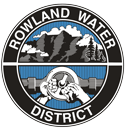New Restrictions Include Limitations to Outdoor Watering
In response to the State Water Resources Control Board, Rowland Water District (RWD) will impose restrictions on the number of days residents can water lawns and outdoor areas. In addition, the state is requiring local water districts to maximize leak detection efforts, report monthly water usage, and increase enforcement on previously issued water restrictions. Outdoor watering will be limited to two days per week in order to conserve as much water as possible during these severe drought conditions that California continues to experience.
“As the severity of the drought deepens, we continue to find ways to conserve and protect our potable water supply, and we will continue to work with the state to ensure all measures are properly enforced,” says Szu Pei Lu-Yang, RWD Board President. “The state will continue to assess the situation, and likely provide more guidance on water conservation measures in the coming weeks and months. We are dedicated to working with our customers to ensure the reliability and sustainability of our water supply moving forward.”
The State Water Resources Control Board has already implemented the following restrictions:
Prohibitions for ALL urban water users in California include:
- The application of potable water to any driveway or sidewalk.
- Using potable water to water outdoor landscapes in a manner that causes runoff to adjacent property, non-irrigated areas, private and public walkways, roadways, parking lots or structures.
- Using a hose that dispenses potable water to wash a motor vehicle, unless the hose is fitted with a shut-off nozzle.
- Using potable water in a fountain or decorative water feature, unless the water is re-circulated.
Last week the State Water Resources Control Board adopted expanded emergency regulations to safeguard the state’s remaining water supplies. In a prepared statement, the organization said, “While Californians have made great strides to conserve water, more effort is needed.” In addition to the earlier state mandated measures, some of the restrictions now required of RWD customers include:
- No watering or irrigation of lawn, landscape or other vegetated area with potable water between the hours of 8:00 a.m. and 5:00 p.m.
- Eliminate watering or irrigating of any lawn, landscape or other vegetated area in a manner that causes or allows excessive water flow or runoff onto an adjoining sidewalk, driveway, street, alley, gutter or ditch.
- Washing down of hard or paved surfaces, including but not limited to sidewalks,walkways, driveways, parking areas, tennis courts, patios or alleys, should only be done when using a bucket or similar container, a hand-held hose equipped with a positive self-closing shut-off device, a low volume, high-pressure cleaning machine, or a low-volume high-pressure water broom.
- Eating or drinking establishments, including but not limited to restaurants, hotels, cafes, bars or other public places where food or drinks are sold or served should provide drinking water to patrons only upon request.
- Watering or irrigation of lawn, landscape or other vegetated area with potable water is limited to two days per week (Monday and Friday).
- Using water to wash motor vehicles, trailers, boats and other types of mobile equipment is prohibited except by use with a bucket or hand-held hose equipped with a positive self-closing water shut-off nozzle or device.
- Emptying or refilling swimming pools, spas and ponds for cleaning purposes is prohibited. Water levels may be maintained.
- Water consumption as measured through the customer’s meter shall be reduced by the customer by twenty percent (20%).
A comprehensive list of the restrictions adopted by the RWD Board of Directors is available online at www.rwd.org, under the “Conservation/Education” section Drought Update and you are encouraged to familiarize yourself with all the mandated conservation measures.
“We are asking for your commitment to preserve our most precious natural resource,” says RWD General Manager Tom Coleman. “Together, we can all make a difference and ensure water supply reliability for future generations by following these few simple steps.”
Improvements to the water supply infrastructure, larger storage capacity, and tapping new sources of water are all keys to building a sustainable water supply for Rowland Water District, in preparation for this type of drought emergency. Drought periods are not uncommon for California, and understanding that has led to a strong level of preparation within the water community. Rowland Water District continues to invest in important conservation measures, and continues to develop new sources for a reliable potable water supply.
###
